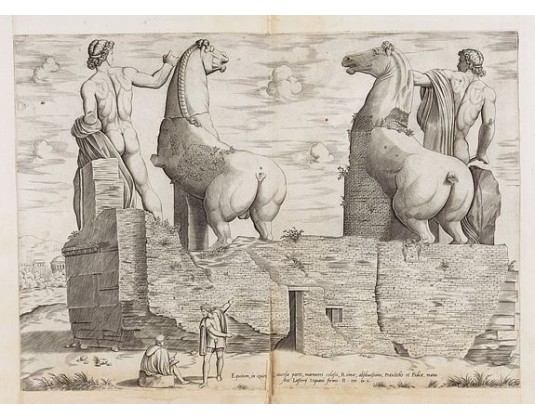LAFRERI, Antonio. - Equitum in Quirinali, aversa parte, marmorei colossi Romae; absolutissima Praxitelis et Fidiae manu.
 Click on image to zoom
Click on image to zoom

Description
Published in the "Speculum Romanae Magnificentiae" (The Mirror of Roman Magnificence). The plate appears in the Index of Lafreri at n. 230, listed as "Caualli di Praxitelle et Fidia di forma dinanti et di retro separati sono nel monte Quirinale detto monte Cauallo".
The Dioscuri are two immense statues of horse tamers, variously said to be Castor and Pollux or Alexander and Bucephalus. Standing over five meters high, they are ancient Roman replicas of Greek originals from the 5th century BC. In the latter years of the Roman Empire, they were treated as originals and inscribed with attributions to the famous Greek sculptors Praxiteles and Phidias. (It was not unusual for the names of legendary artists to be attached to esteemed works of art centuries later.)
When Lafrery published his original engraving, they were on the Quirinal, one of the hills of Rome, at the Baths of Constantine. In 1588, Pope Sixtus V restored the statues and moved to the Piazza del Quirinale. Since 1818, the statues have been incorporated into what is now known as the Fountain of the Dioscuri in the center of the piazza, including an Egyptian obelisk and an ancient Roman basin.
Since the Middle Ages all visitors to Rome have been able to admire them in the same place where they are still today and because of their presence the Quirinal was called Montecavallo.
Antonio Lafreri (French, Orgelet, Franche-Comte ca. 1512–1577 Rome). "The Speculum Romanae Magnificentiae (The Mirror of Roman Magnificence) found its origin in the publishing endeavors of Antonio Salamanca and Antonio Lafreri. During their Roman publishing careers, the two foreign publishers - who worked together between 1553 and 1563 - initiated the production of prints recording artworks, architecture, and city views related to Antique and Modern Rome. The prints could be bought individually by tourists and collectors but were also purchased in larger groups, often bound together in an album.
In 1573, Lafreri commissioned a title page, where the title ‘Speculum Romanae Magnificentiae’ first appears. Lafreri envisioned an ideal arrangement of the prints in 7 different categories, but he never appears to have offered one standard, bound set of prints during his lifetime. Instead, clients composed their own selection from the corpus to be bound, or collected a group of prints over time. When Lafreri died, two-thirds of the existing copper plates went to the Duchetti family (Claudio and Stefano), while another third was distributed among several publishers.
The Duchetti appears to have standardized production, offering their clients a more or less uniform version of the Speculum. The popularity of the prints also inspired other publishers in Rome to make copies, however, and to add new prints to the corpus" (The Met, New York).
- Reference N°: 49138
